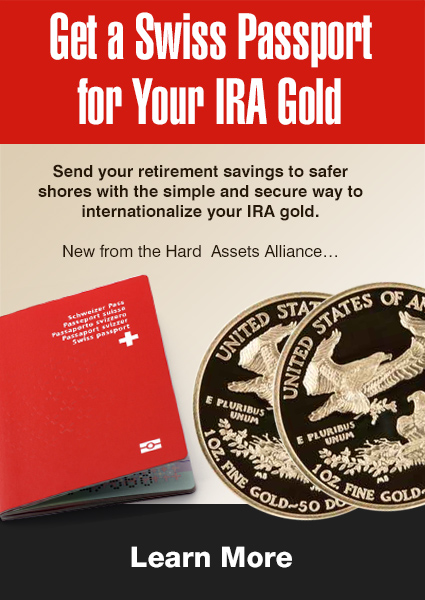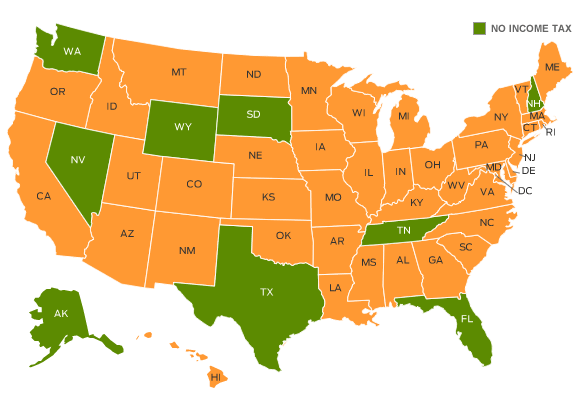By Jeff Clark, Editor of BIG GOLD
“Gold is one of the dumbest things to put in your IRA,” said the slick TV commentator, with his $200 haircut, perfect white teeth, and superior attitude. “Everyone knows income-producing vehicles are best for an IRA.”
I tried to ignore the prepackaged message from someone who sounded like he hadn’t given any more thought to the topic than what he’d read somewhere. His advice was misleading and incomplete, and I wondered how many viewers might weaken their portfolios by acting on his sound bite.
On one hand, he’s right: the tax-advantaged nature of an IRA makes income-generating assets ideal, especially when you factor in compounding. Gold generates no income.
And there’s another drawback to putting gold in an IRA, one the slick TV journalist probably never even thought of: you lose confidentiality. Gold is one of the last assets in modern society that still offers this advantage—and you’d have to give it up if you stick it in an IRA.
So on a cursory level, one might nod along with the empty suit on TV and conclude that gold should be excluded from a retirement account. But these concerns are only reasons not to hold all your precious metals in an IRA, or have your retirement account be comprised entirely of gold. Indeed, the reasons to put some gold in an IRA have grown—in fact, it might be a major strategic mistake not to have a gold IRA…
A Gold IRA Is a Strategic Portfolio Move
There are solid, core reasons why every investor should have some gold in an IRA. See which of these factors apply to you…
Your IRA is one of your biggest—or only—investment accounts. If an IRA is where most of your investment funds are housed, it may be your only chance to add physical metal to your portfolio.
You want to diversify into a non-financial asset. Think about it: if your retirement account consists of just stocks and bonds, then all of your IRA investments are in paper assets. In today’s world, that’s the pinnacle of risk.
Tax-advantaged growth. As with any asset, gains can compound tax-deferred inside an IRA (or tax-free in a Roth). The additional advantage with precious metals is that you can shift the allocation and not trigger a taxable event—for example, if you wanted to lighten up on gold to buy some silver.
Retirement inflation hedge. To have no inflation hedge in a retirement portfolio seems especially shortsighted in today’s monetary environment. Remember, regardless of what the “profit” column shows on your statement each year, those gains have to be adjusted for inflation—you’re eventually going to spend some of that money, after all. A dividend mutual fund yielding 2%, for example, nets you nothing after accounting for the current rate of inflation. And the further away you are from withdrawing the funds, the longer inflation is eating away at your account value. The answer is to utilize one of the best inflation hedges known to man.
If you share our concern about the consequences of global fiscal and monetary excesses, holding some physical precious metals inside a retirement vehicle is a prudent move. The Hard Assets Alliance provides that service. As you’ll see below, the Hard Assets Alliance just opened the door to international storage for IRA holders.
But first, why should we use the Hard Assets Alliance and not one of the other programs you might see advertised? Well, for the same reason we no longer start our cars with a crankshaft…
The Horse-and-Buggy Industry of the 21st Century
The process to set up a gold IRA has traditionally been slow and cumbersome. US law requires that IRA assets be held at a trust company to ensure proper tax reporting and recordkeeping. However, most gold dealers are not trust companies. For them to offer physical gold IRAs, they must partner with a trust company that’s willing to hold physical gold.
So when a gold dealer offers to purchase gold within an IRA, the process for the investor looks like this:
- Open an account with a gold dealer
- Open a separate IRA account with a trust firm (usually done via snail mail)
- Fund your account with the trust
- Request a purchase of metals from your chosen vendor
- Wait for funds to transfer and your order to settle
This procedure takes 30-45 days—it still takes a month, even if you already have an IRA or a relationship with a dealer. Further, dealers typically charge high fees when purchasing gold for an IRA. And when you want to sell or take a distribution, get ready for more paperwork, verification checks, and shipping fees, all of which take another 2-3 weeks.
This “manual” process has led to lengthy delays, unexpected costs, and never-ending frustrations. Check out some of the common complaints IRA holders have had with this antiquated system…
- IRA transfers can take up to 30 days to execute, depending on the follow-up procedures of the custodian.
- Deposit confirmations are not always sent to the client in a timely manner and are not automated.
- Clients cannot lock in an order until the custodian verifies the cash balance with the dealer, exposing them to market risk.
- The purchasing process typically takes 8-10 business days to settle.
- Metals must be shipped to the custodian’s vaulting facility, and the IRA holder is responsible for those costs.
- Deliveries to the vaulting location may not be tracked by the custodian, nor are the deliveries compared to the order invoice for accuracy of delivery. This has been a growing concern by investors.
- Limited storage options. Most custodians only offer one or two storage locations, and most of those are in Delaware.
- The sell process is costly, cumbersome, and time consuming.
- Poor customer service is one of the biggest complaints. When the client has questions about his IRA or order, the dealer refers him back to the custodian—and the custodian refers him back to the dealer! The client is often passed around without ever getting his questions answered.
This doesn’t sound fun. Fortunately, the Hard Assets Alliance has completely changed how business is done with gold IRAs…
The New “Gold” Standard in IRAs
HAA’s program has streamlined the entire gold/IRA process and greatly reduces the time and hassle to open an account. In most cases, you can do everything online. It’s a breakthrough service, and we want to highlight it now, before the April 15 deadline, so you can still make a 2013 contribution.
The Hard Assets Alliance IRA reduces both time and hassle. The online platform lets you electronically create an IRA account and a trust account simultaneously. Entrust, a well-known custodian, provides the trust account, and it receives your application in real time. In most cases, it takes only 10-15 minutes to open a traditional or Roth IRA account; SEP and SIMPLE accounts take about one to two weeks to process, and Entrust will work with you to facilitate transfers. The process is straightforward and user-friendly.
Further, there are no additional fees to purchase or sell precious metals within a Hard Assets Alliance IRA. And like all Hard Assets Alliance products, all buying and selling can be done online.
As far as we know, this is the only fully automated online IRA trading system to offer physical precious metals.
The process is straightforward. You open an IRA account at the Hard Assets Alliance, and your application is automatically sent to Entrust. The submittal process takes about five minutes, and once approved, you can fund your account. An additional form is required for SEP and SIMPLE accounts. You can also fund your account by transferring a full or partial existing 401k into a Hard Assets Alliance IRA.
If you’re already a Hard Assets Alliance customer, you can create a separate IRA account using your existing username and password, and toggle between accounts.
The Hard Assets Alliance portal will notify you electronically once you’re approved (typically within two business days), and then you can fund your account. All funds go directly to Entrust since it’s the custodian. Upon receipt, it notifies the Hard Assets Alliance of your deposit, and your funds are available to purchase metal the next business day. It also takes care of all reporting, including tax statements.
The Hard Assets Alliance makes buying (and selling) easy; it’s all done online at your convenience, and comes with industry-low commissions since your order is bid out to a network of dealers. Further, only IRA-permissible bars and coins are displayed for purchase. The rules can get a tad complicated—that’s been another hazard: buy the wrong form of gold for a retirement vehicle, and you risk invalidating the entire IRA, triggering an unwelcome taxable event. No worries with the Hard Assets Alliance.
And Now You Can Store Your IRA Gold in Zurich
Until now, foreign gold storage for IRAs, while available for US investors, has been a tedious process, with the setup requiring a good deal of time, paperwork, and expense. However, the Hard Assets Alliance just announced that its vault in Zurich, Switzerland can be used to store Gold Eagles (only) in an IRA with the same ease and convenience of a US IRA. This gives us an international storage option for our gold—and in one of the strongest jurisdictions to boot.
This is a breakthrough offering in the industry—one you won’t find elsewhere. The minimum for this vault is $10,000 (the Hard Assets Alliance only requires $5,000 for US storage). If you don’t meet the minimum, open an account and fund it over time with a monthly direct deposit. By opening your account now, it can be ready to go when you are.
The reasons to put some gold in an IRA are mounting. And with the Hard Assets Alliance, we can avoid the VHS-tape versions of the industry and jump straight to Blu-ray. I encourage you not to put off making this strategic move for your retirement account.
Disclaimer
The Hard Assets Alliance website and the SmartMetals Investor are published by Hard Assets Alliance, LLC. Information contained in such publications is obtained from sources believed to be reliable, but its accuracy cannot be guaranteed. The information contained in such publications is not intended to constitute individual investment advice and is not designed to meet your personal financial situation. The opinions expressed in such publications are those of the publisher and are subject to change without notice. The information in such publications may become outdated, and there is no obligation to update any such information.
Any Hard Assets Alliance publication or website and its content and images, as well as all copyright, trademark, and other rights therein, are owned by Hard Assets Alliance, LLC. No portion of any Hard Assets Alliance publication or website may be extracted or reproduced without permission of Hard Assets Alliance, LLC. Nothing contained herein shall be construed as conferring any license or right under any copyright, trademark, or other right of Hard Assets Alliance, LLC. Unauthorized use, reproduction, or rebroadcast of any content of any Hard Assets Alliance publication or website is prohibited and shall be considered an infringement and/or misappropriation of the proprietary rights of Hard Assets Alliance, LLC.
Hard Assets Alliance, LLC reserves the right to cancel any subscription at any time. Cancellation of a subscription may result from any unauthorized use or reproduction or rebroadcast of any Hard Assets Alliance publication or website, any infringement or misappropriation of Hard Assets Alliance, LLC’s proprietary rights, or any other reason determined in the sole discretion of Hard Assets Alliance, LLC.
Affiliate Notice: Hard Assets Alliance has affiliate agreements in place that may include fee sharing. If you have a website or newsletter and would like to be considered for inclusion in the Hard Assets Alliance affiliate program, please contact us. Likewise, from time to time Hard Assets Alliance may engage in affiliate programs offered by other companies, though corporate policy firmly dictates that such agreements will have no influence on any product or service recommendations, nor alter the pricing that would otherwise be available in absence of such an agreement. As always, it is important that you do your own due diligence before transacting any business with any firm, for any product or service.
© 2014 Hard Assets Alliance, LLC.









